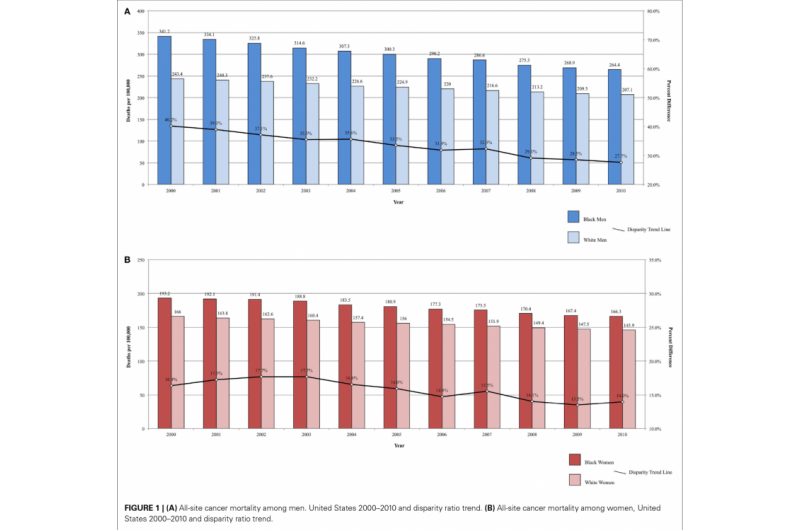Racial disparity in cancer mortality is narrowing, suggests new study

Cancer mortality remains significantly elevated among African Americans. Between 2000 and 2010, overall mortality from cancer decreased faster among African American women and men than among Caucasians. If current trends continue, racial disparities in cancer outcomes are expected to narrow further and might disappear over time.
"Health Equity"—defined by the US Department of Health and Human Services as the highest level of health for all people—has not yet been achieved in America. For example, in 2010 the total mortality rate from cancer was approximately one-fifth higher among African Americans than among Caucasians. The causes of this disparity are complex, but risk factors for cancer that disproportionately affect African Americans include low education and income, and living in less healthy neighborhoods with reduced access to quality healthcare.
In a new study, Clinical Professor of Health Sciences Eileen O'Keefe and colleagues from Boston University College of Health & Rehabilitation Sciences: Sargent College and Slone Epidemiology Center, report major changes in cancer mortality in African Americans and Caucasians during the first decade of the 21st century. The researchers analyzed representative nation-wide data from the "Surveillance, Epidemiology, and End Results" (SEER) program of the National Cancer Institute.
O'Keefe and colleagues demonstrate that the disparity between African Americans and Caucasians in total cancer mortality decreased by 14.6% (from 16.4 to 14.0%) in women and 31.1% (from 40.2 to 27.7%) in men during this period. This is due to a faster decrease in cancer mortality among African Americans than among Caucasians. Should these trends continue, racial disparities in cancer outcomes would continue to narrow, and might potentially be eliminated over time.
The progress in cancer outcomes for African Americans seems to be partly driven by increased access to high-quality treatment and surgery, and partly by successful prevention strategies. The latter include helping people to quit smoking; more widespread screening and testing, which allows for earlier diagnosis and raises the probability that treatment will be successful; a decrease in the prescription of hormone replacement therapy (a risk factor for breast cancer) to women in the menopause; and an increase in the prescription of anti-inflammatory drugs that lower the risk of colorectal cancers.
Even if these trends are encouraging, O'Keefe and colleagues warn against over-optimism: "Despite significant gains in overall cancer mortality over this time period, persistent cancer disparities by race exist. (...) Policy solutions that address access to and quality of the health care system are certainly important toward narrowing disparities, but cannot fully redress broader societal inequities at the core of racial and ethnic health disparities."
The study is published in the open-access journal Frontiers in Public Health.
Other results include:
• In 2010, the total number of cancer-related deaths per 1000 Americans per year was 1.7 among African American women (down by 16% compared to 2000), 1.5 among Caucasian women (down by 14%), 2.6 among African American men (down by 29%), and 2.1 among Caucasian men (down by 18%).
• The fastest decrease in cancer-related mortality was for prostate cancer among African American men (down by 43% in 2010 compared to 2000), followed by prostate cancer among Caucasian men (down by 38%), and lung cancer among African American men (down by 37%). The slowest decrease was for lung cancer among Caucasian women (down by 7%) and African American women (down by 9%).
• In African American and Caucasian women, the mortality rate due to lung, breast, and colorectal cancer declined between 2000-2010 by 7% to 36%, depending on cancer type and ethnicity.
• In African American and Caucasian men, the mortality rate due to lung, prostate, and colorectal cancer declined between 2000-2010 by 26% to 43%, depending on cancer type and ethnicity.
• Lung cancer was the only type of cancer included in the present study for which African Americans had a lower mortality rate than Caucasians, and this was only the case in women. The main cause is the historically lower prevalence of smoking among African American women compared to Caucasian women.
More information: Racial disparities in cancer mortality in the United States, 2000-2010, Frontiers in Public Health, O'Keefe EB, Meltzer JP and Bethea TN, DOI: 10.3389/fpubh.2015.00051















